Laundry is an integral part of our lives, a chore that transcends cultures and geographies.
Whether you’re a student in a dorm or a parent in a suburban home, laundry is a task you can’t avoid.
But have you ever stopped to think about the numbers behind this everyday activity?
This article aims to provide a comprehensive look at laundry statistics, from the time and money we spend to the environmental impact and gender roles involved.
Key view of some interesting data:
- 35 Billion Loads Annually: In the U.S., 660 million laundry loads are washed every week, totaling 35 billion loads each year.
- Invisible Soil: About 70% of the soil in your laundry is invisible, consisting mainly of “human matter” like dead skin cells, sweat, and body oils.
- Fragrance Sensitivities: Over 30% of people experience headaches or breathing difficulties due to artificial fragrances in laundry products.
- Astronauts’ Laundry: In space, astronauts incinerate their underwear due to the absence of washing machines.
- WWI Detergent Invention: A soap shortage during World War I led to the invention of laundry detergent.
- Historical Cleaning Methods: Before modern detergents, people used a mixture of ashes and urine to clean their clothes.
The Frequency and Time Spent on Laundry
How often do you find yourself standing in front of the washing machine? If you’re like most people in the United States, you’re handling between 8 to 10 loads of laundry per week.
Globally, 67% of people say they do laundry at least twice per week, another 31% claim to do it every day, and 2% fall into the unknown or other category.
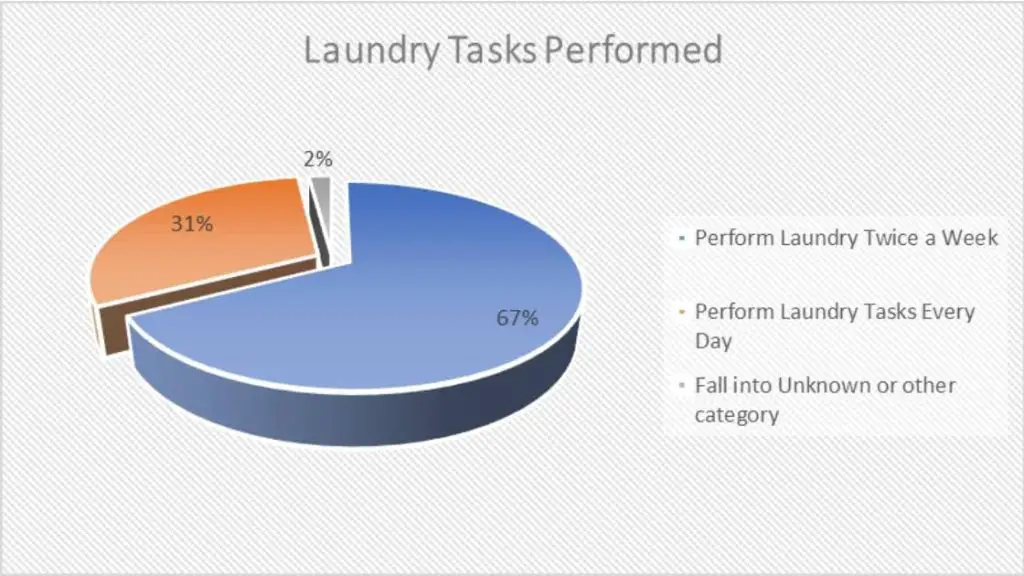
When it comes to time investment, the average American family of four spends approximately 12 hours each month on laundry.
That’s nearly half a day dedicated solely to sorting, washing, drying, and folding! According to the American Time Use Survey, women spend an average of 17 minutes per day on this chore, while men spend just 5 minutes.
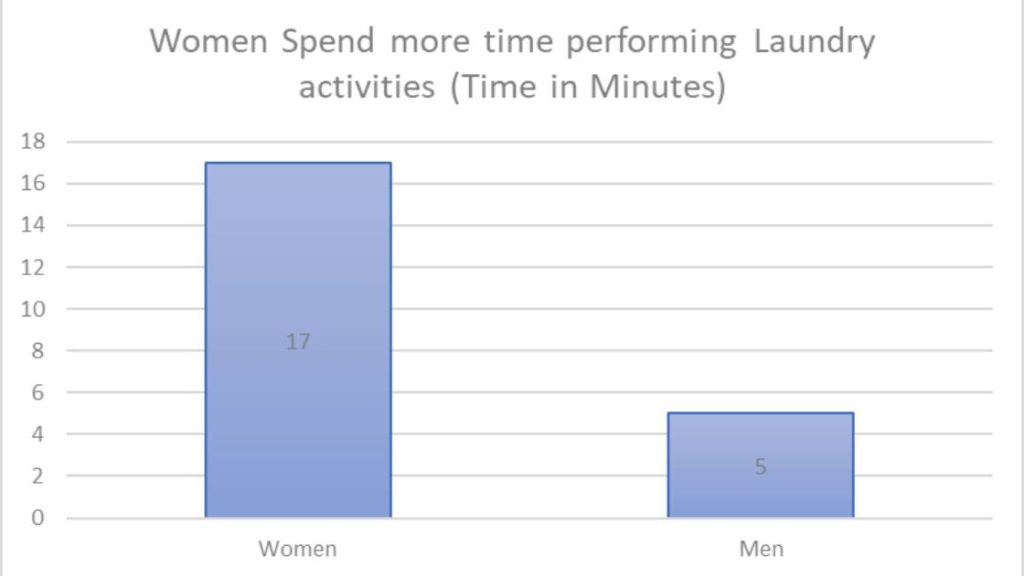
This disparity in time spent is not just a U.S. phenomenon; it’s a global trend that raises questions about gender roles, which we’ll delve into later.
The Financial Aspect of Laundry
Laundry isn’t just time-consuming; it’s also a significant financial commitment.
The laundry care market worldwide is projected to reach a staggering value of US$122.50 billion by 2028.
In the U.S. alone, the laundry facilities & dry-cleaning services market was estimated at USD 10.82 billion in 2021 and USD 11.17 billion in 2022.
Key Stats worth reading:
- On a household level, the average American spends about $100 per year on laundry detergent and an additional $50 on dry cleaning.
- When you consider the annual cost of doing 416 loads of laundry; around $140 not including bleach or fabric softener, the numbers start to add up.
- The worldwide laundry care market has been experiencing growth with notable revenue figures. The Home & Laundry Care market is projected to grow by 4.20% (2023-2028), resulting in a market volume of US$239.80 billion in 2028.
- If everything goes well the market is expected to register a 5.7% CAGR in terms of value between 2023 and 2033.
- Overall, the laundry care market is forecasted to continue its growth trajectory in the coming years.
Based on the CAGR value of 4.20% and 5.7% CAGR here’s a growth prediction for the global laundry care market:
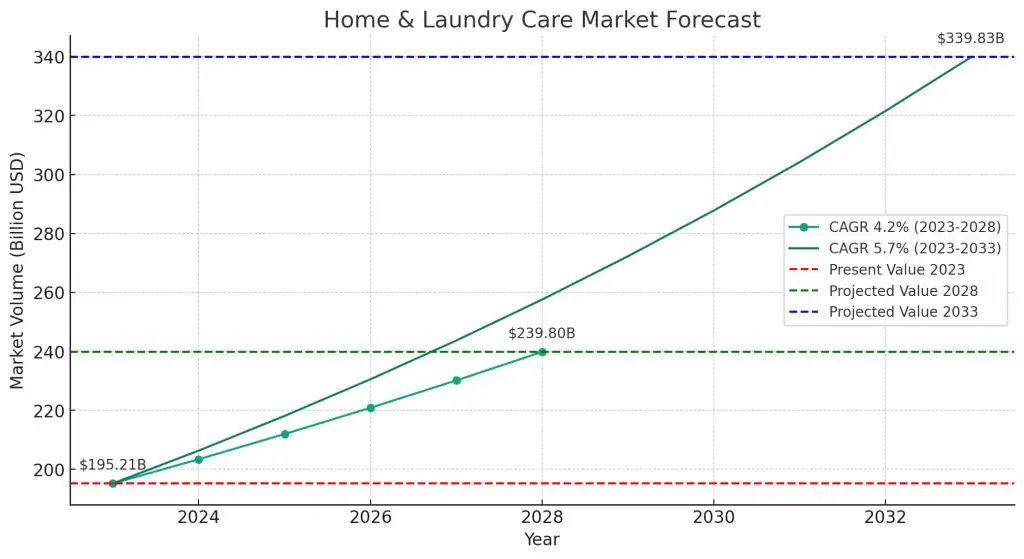
Fact: Did you know most laundromats operate with a profit margin ranging between 10% and 35%?
Environmental Impact
The environmental footprint of our laundry habits is a growing concern.
Washing machines use anywhere between 100 and 200 liters of water per load, contributing to 19 billion cubic meters of water usage annually.
Heating this water accounts for 90% of a washing machine’s energy consumption.
Moreover, a clothes dryer is responsible for approximately 6% of the average home’s energy use.
But the environmental impact doesn’t stop there, laundry detergent is a major source of microplastic pollution, with a single load releasing up to 700,000 microplastic fibers into the water.
These microplastics can harm marine life and eventually enter the human food chain. Some countries have even enacted laws to ban certain types of microplastics in laundry detergents.
Gender Roles and Laundry
When it comes to laundry, gender roles are glaringly apparent.
Women do a staggering 88% of the laundry in the United States, a statistic that raises eyebrows and questions about societal norms.
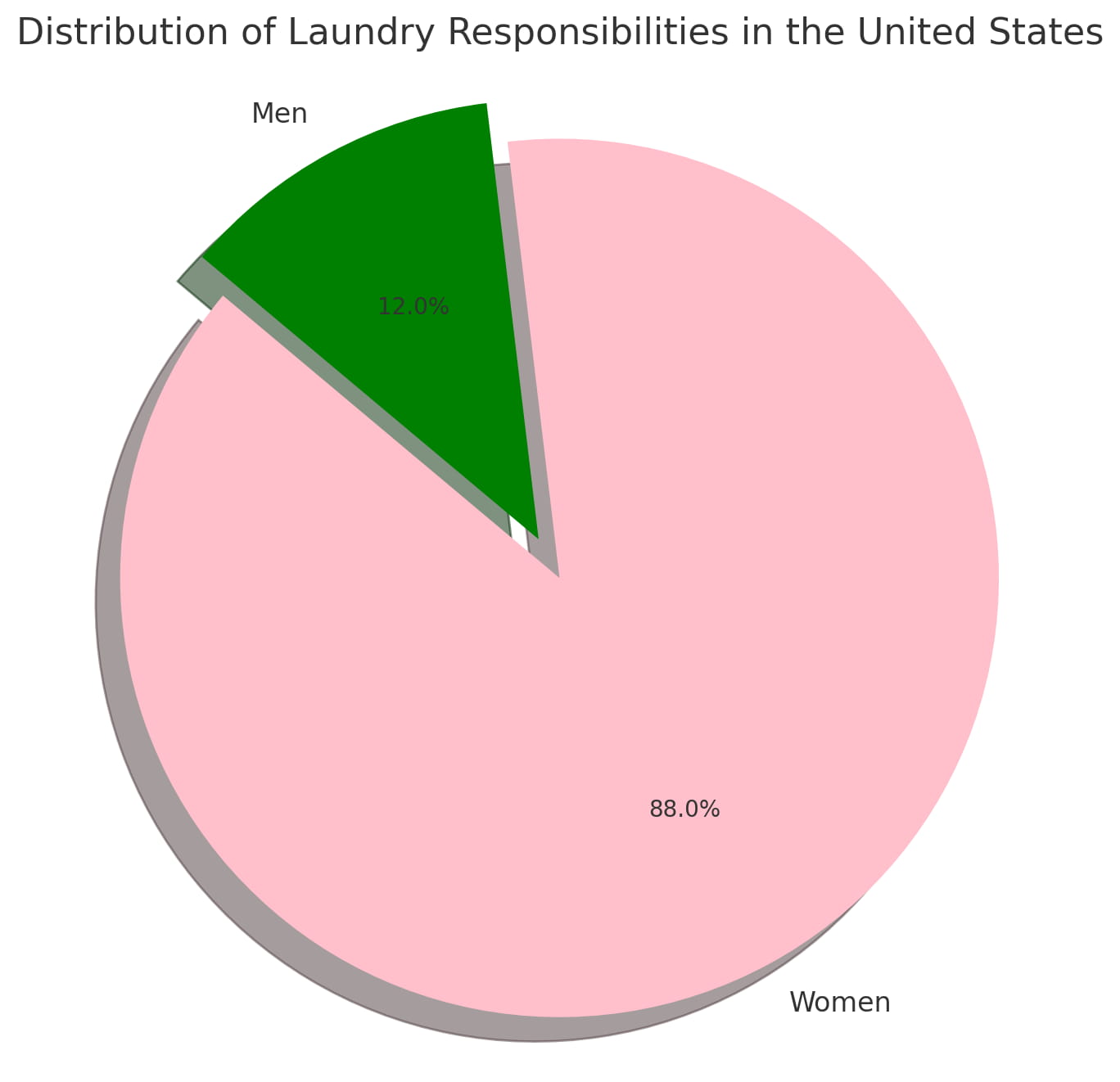
This isn’t just a domestic issue; it’s a global trend.
Women spend an average of 17 minutes per day on laundry, translating to almost 2 hours per week. In contrast, men spend a mere 28 minutes weekly.
The reasons for this disparity are complex and rooted in traditional gender roles that have persisted over time.
However, as society moves towards greater gender equality, it’s crucial to address this imbalance and encourage shared responsibility within households.
Technological Advancements and Innovations
The laundry room has seen significant technological advancements over the years.
The first mass-marketed electric washing machine, known as ‘Thor,’ was developed in 1908.
Since then, washing machines have evolved to become more energy-efficient and user-friendly.
Modern machines use between 350 to 500 watts of electricity per use, a far cry from their energy-guzzling predecessors.
Dryers, too, have come a long way, once a luxury item due to its high cost, dryers became a household staple only in the 1960s.
Today, they are responsible for about 6% of the average home’s energy use, highlighting the need for more energy-efficient models.
Laundry Practices Around the World
Laundry habits vary significantly across different regions.
In the Asia-Pacific area, hand washing is more prominent, while only 46% of people in Africa and the Middle East own a washing machine.
These statistics not only reflect cultural differences but also economic disparities between regions.
Interestingly, people in the Asia-Pacific region are more likely to use eco-friendly laundry detergents, aligning with a global trend toward sustainability.
On the other hand, in places like India, the laundry services market has seen exponential growth, estimated to be worth over Rs 20,000 crores, and is expected to grow at a CAGR of 7.5% over the next five years.
So based on the above numbers, here is the growth projection for the laundry market in India.
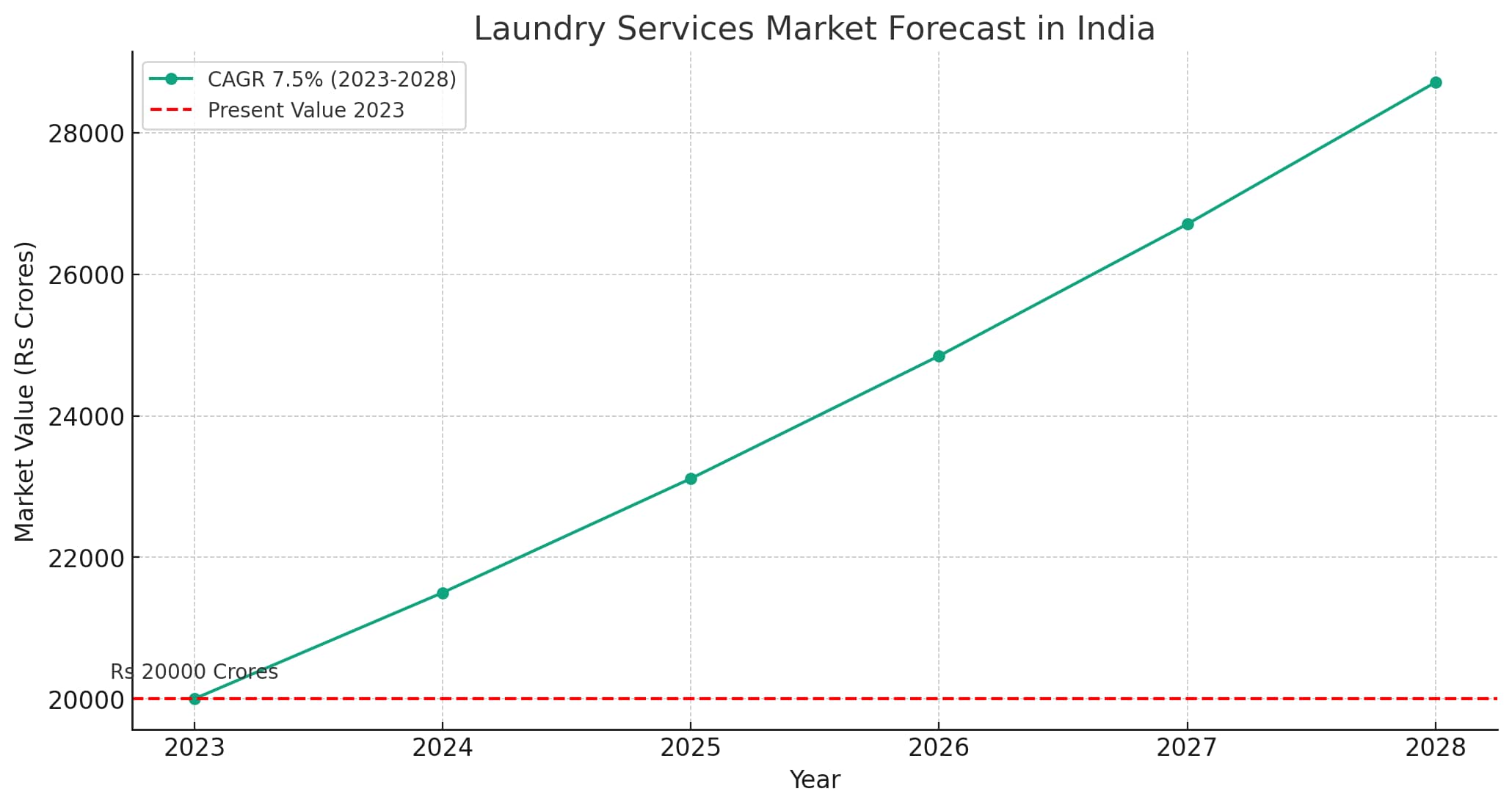
Fun Fact: Did you know that Walt Disney World does 285,000 pounds of laundry every day?
Additional Interesting Stats
Laundry is not just about tossing clothes into a machine; it’s a complex activity with numerous facets. Here are some additional intriguing statistics to consider:
- In the United States, a staggering 660 million laundry loads are washed every week, amounting to 35 billion loads annually. This translates to an astonishing 100 million tons of clothes.
- Believe it or not, 70% of the soil in your laundry is invisible. This hidden grime consists of “human matter” like dead skin cells, sweat, and body oils.
- Fragrance sensitivities are on the rise, with over 30% of people experiencing headaches or breathing difficulties due to artificial fragrances in laundry products.
- The average adult sweats about 6 liters a day, half of which comes from the feet alone. This adds a whole new layer to the importance of laundry hygiene.
- Ironing has a long history, dating back to Ancient China. The first ironing board, however, was invented much later, in New York in 1858.
- In space, astronauts have no choice but to incinerate their underwear due to the absence of washing machines. Talk about extreme laundry solutions!
- During World War I, a soap shortage led to the invention of detergent, changing laundry practices forever.
- The cost of an electric washer in the 1920s was $81.50, equivalent to about $1010.94 in today’s money, highlighting the luxury that washing machines once were.
- Before modern detergents and washing machines, people used a mixture of ashes and urine to clean their clothes. This historical tidbit puts our current laundry practices into perspective.
Final Thoughts
Laundry is more than just a household chore; it’s a multi-billion-dollar industry with significant environmental and societal implications.
From the time and money we invest to the water and energy we consume, understanding these statistics can help us make more informed decisions.
As we move towards a more sustainable and equal future, it’s crucial to be aware of our laundry habits and their broader impact.
References
- Ohsospotless.com
- Statista.com
- Bosistos.com.au
- Wayzatahomelaundry.com
- Laundryfaqs.com
- Dropps.com
You May Also Like
- 50+ Washing Machine Statistics worth reading
- Decoding India’s Washing Machine Trends with Statistics
- Average Washing Machine Weight (with examples)
- What’s the Average Height of a Washing Machine?
- How to Calculate Power Consumption of Washing Machine?
- How to Calculate Washing Machine Capacity? (With formula)
- Common washing machine accidents and how to prevent them





